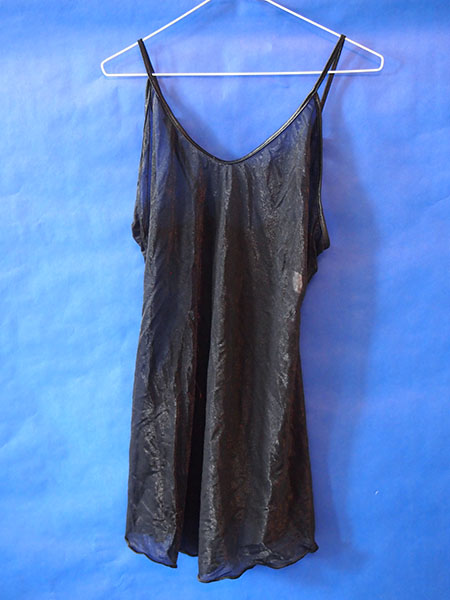![]() body | color | collections | commodity | cube | document | fabric | fetish | gender | glass | home | identity | living | machine | metal | minimal | mobility | narrative | olfactory | organic |
body | color | collections | commodity | cube | document | fabric | fetish | gender | glass | home | identity | living | machine | metal | minimal | mobility | narrative | olfactory | organic |
![]() pain | paper | plastic | plugs | power | protective | rectangular | ritual | round | sound | souvenir | spiritual | style | text-based | time | tool | touch | uniform | value | visual | warm | wood
pain | paper | plastic | plugs | power | protective | rectangular | ritual | round | sound | souvenir | spiritual | style | text-based | time | tool | touch | uniform | value | visual | warm | wood
| Clothing: Black Sheer Dress | |||
Narrative: Shame Jason Chan bought this with me with some of his bonus money from working at a bookstore in 1999 Cellulose acetate fiber is one of the earliest synthetic fibers and is based on cotton or tree pulp cellulose ("biopolymers"). These "cellulosic fibers" have been replaced in many applications by cheaper petro-based fibers (nylon and polyester) in recent decades. The Federal Trade Commission definition for acetate fiber is "A manufactured fiber in which the fiber-forming substance is cellulose acetate. Where not less than 92 percent of the hydroxyl groups are acetylated, the term triacetate may be used as a generic description of the fiber." Acetate is derived from cellulose by deconstructing wood pulp into a purified fluffy white cellulose. Actually a generic name to a class of polymers called alphaic polymers. Nylon is a synthetic fiber of a class of synthetic polymers developed in early to mid 1900’s. It was the world’s true first synthetic fiber. It is formally attributed to DuPont and Dr. Wallace Carouthers deemed the father of polymers. It is made by repeating bonds and is frequently referred to as a polymide. Nylon fibers specifically are made in a process known as “melt spinning”; syrupy polymer (adipic acid and hexamethylene diamine) solution produced then extruded through a spinneret. When fiber strings emerge they are cooled by air and stretched over rollers to stabilize molecular chains and strengthen the fibers. It was intended to replace silk and substituted for it in WWII including parachutes, flak vests, and vehicle parts including tires and that initiative enhanced speed of research and development. Currently joins rank with polyester in inexpensive mass manufacturing of goods – in 2010 & 2011 the global consumption of nylon was 4 Billion tons annually in filament yarn as well as fibers.
|
 |
||
![]()
